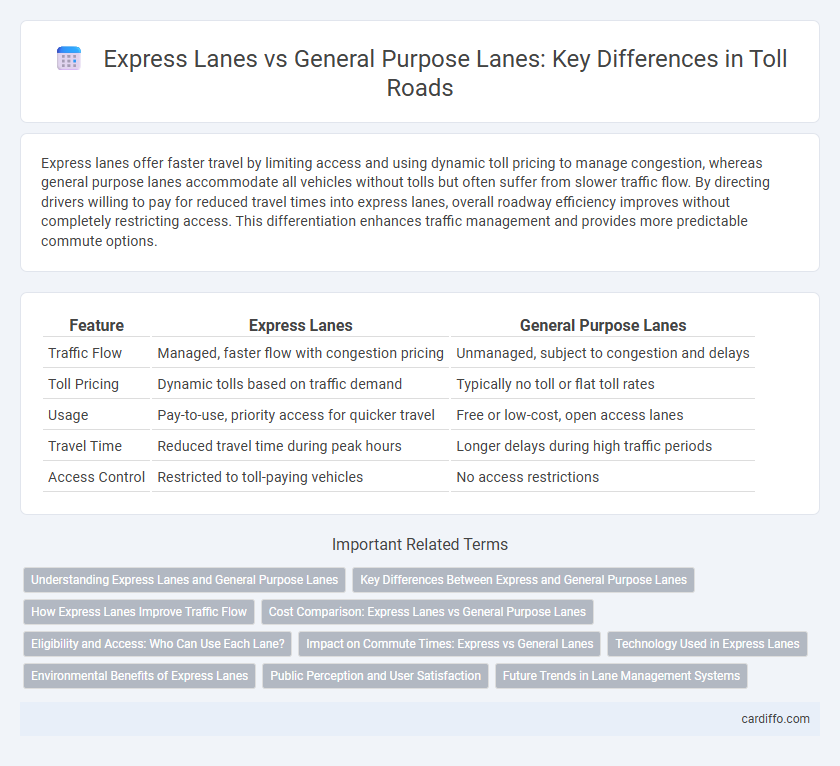Express lanes offer faster travel by limiting access and using dynamic toll pricing to manage congestion, whereas general purpose lanes accommodate all vehicles without tolls but often suffer from slower traffic flow. By directing drivers willing to pay for reduced travel times into express lanes, overall roadway efficiency improves without completely restricting access. This differentiation enhances traffic management and provides more predictable commute options.
Table of Comparison
| Feature | Express Lanes | General Purpose Lanes |
|---|---|---|
| Traffic Flow | Managed, faster flow with congestion pricing | Unmanaged, subject to congestion and delays |
| Toll Pricing | Dynamic tolls based on traffic demand | Typically no toll or flat toll rates |
| Usage | Pay-to-use, priority access for quicker travel | Free or low-cost, open access lanes |
| Travel Time | Reduced travel time during peak hours | Longer delays during high traffic periods |
| Access Control | Restricted to toll-paying vehicles | No access restrictions |
Understanding Express Lanes and General Purpose Lanes
Express lanes offer toll-based, high-speed travel options designed to reduce congestion by restricting access to vehicles paying the fee or meeting specific occupancy criteria, while general purpose lanes accommodate all vehicles without tolls but often experience slower traffic flow. These lanes improve traffic management by allowing drivers to choose between cost savings in general lanes or time savings in express lanes. Implementing dynamic pricing in express lanes adjusts toll rates based on real-time traffic conditions, optimizing lane usage and maintaining consistent travel speeds.
Key Differences Between Express and General Purpose Lanes
Express lanes offer faster travel by allowing vehicles to bypass congestion through toll payments, while general purpose lanes are free but often experience higher traffic volumes and slower speeds. Express lanes typically use dynamic pricing to manage demand and maintain optimal flow, whereas general purpose lanes operate without toll controls. The primary difference lies in cost and traffic management strategies, with express lanes prioritizing efficiency and speed for willing payers.
How Express Lanes Improve Traffic Flow
Express lanes reduce congestion by offering drivers a reliable, faster alternative to general purpose lanes, optimizing vehicle throughput and minimizing stop-and-go traffic. Dynamic pricing in express lanes adjusts toll rates based on real-time traffic conditions, effectively managing demand and maintaining steady speeds. This targeted traffic management enhances overall freeway efficiency, reduces travel time variability, and decreases emissions from idling vehicles.
Cost Comparison: Express Lanes vs General Purpose Lanes
Express lanes typically impose tolls that vary based on real-time traffic conditions, leading to higher costs during peak hours but offering faster, more reliable travel times. General purpose lanes are free or supported by standard fuel taxes, resulting in no direct toll cost but increased congestion and longer travel delays. When weighing expenses, express lanes present a premium for time savings, whereas general purpose lanes provide a cost-free option at the expense of potential inefficiency.
Eligibility and Access: Who Can Use Each Lane?
Express lanes are typically reserved for vehicles meeting specific criteria such as solo drivers willing to pay tolls, carpools, or buses, while general purpose lanes remain open to all vehicles without restrictions. Eligibility for express lanes often requires electronic transponders to monitor toll payments and enforce access rules. This system manages traffic flow by incentivizing shared rides and providing faster travel options for those who opt into toll payments.
Impact on Commute Times: Express vs General Lanes
Express lanes significantly reduce commute times by limiting access to vehicles willing to pay tolls, thereby avoiding congestion common in general purpose lanes. General purpose lanes often experience slower traffic flow due to higher vehicle volumes, leading to increased travel time and variability. Studies show that express lanes can cut commute times by up to 30%, providing a reliable and time-efficient alternative to traditional highway lanes.
Technology Used in Express Lanes
Express lanes utilize advanced traffic management technologies such as electronic toll collection systems, dynamic pricing algorithms, and real-time traffic monitoring sensors to optimize flow and reduce congestion. These lanes often rely on transponder-based tolling systems like RFID or DSRC, enabling seamless vehicle identification and toll deduction without stopping. Integration with GPS and mobile applications provides drivers with up-to-date information on lane availability and pricing, enhancing travel efficiency compared to traditional general purpose lanes.
Environmental Benefits of Express Lanes
Express lanes reduce vehicle emissions by maintaining steady traffic flow and minimizing stop-and-go conditions common in general purpose lanes. Reduced congestion in express lanes leads to lower fuel consumption and decreased greenhouse gas emissions, contributing significantly to improved air quality. These environmental benefits support sustainable transportation planning and promote cleaner urban environments.
Public Perception and User Satisfaction
Express lanes are perceived positively for reducing congestion and offering reliable travel times compared to general purpose lanes, enhancing overall user satisfaction. Public surveys indicate that drivers value the choice and time savings provided by tolled express lanes despite the cost, often reporting higher satisfaction rates. However, some users express concerns about equity and affordability, highlighting the need for balanced pricing strategies to maintain public support.
Future Trends in Lane Management Systems
Future trends in lane management systems emphasize the integration of dynamic pricing models in express lanes to optimize traffic flow and reduce congestion. Advanced sensor technologies and real-time data analytics enable more accurate demand forecasting, facilitating adaptive lane allocation between express and general-purpose lanes. Increasing deployment of connected vehicle systems enhances coordination, supporting seamless transitions and improving overall tolling efficiency.
Express lanes vs general purpose lanes Infographic

 cardiffo.com
cardiffo.com